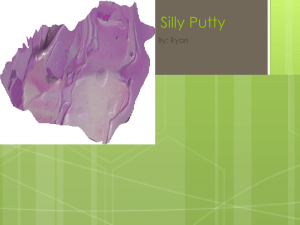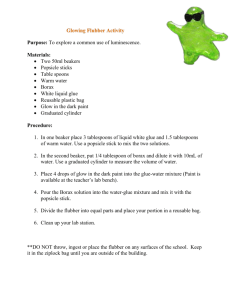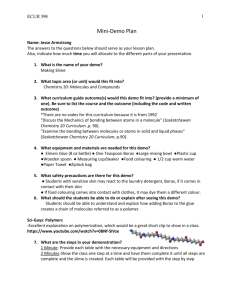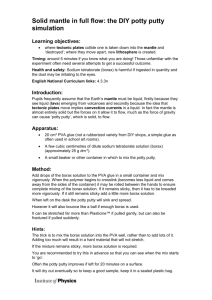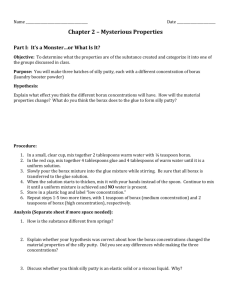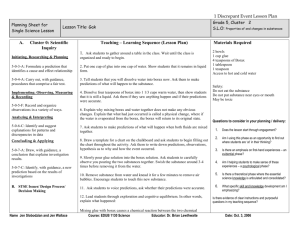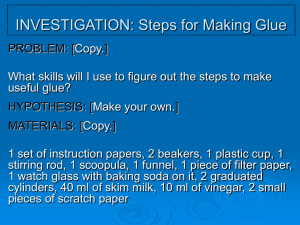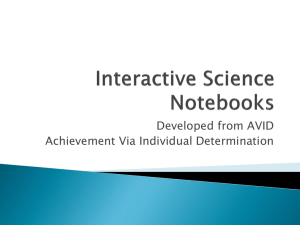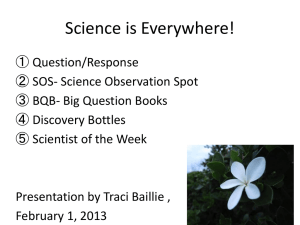Water - Brumby STEM
advertisement
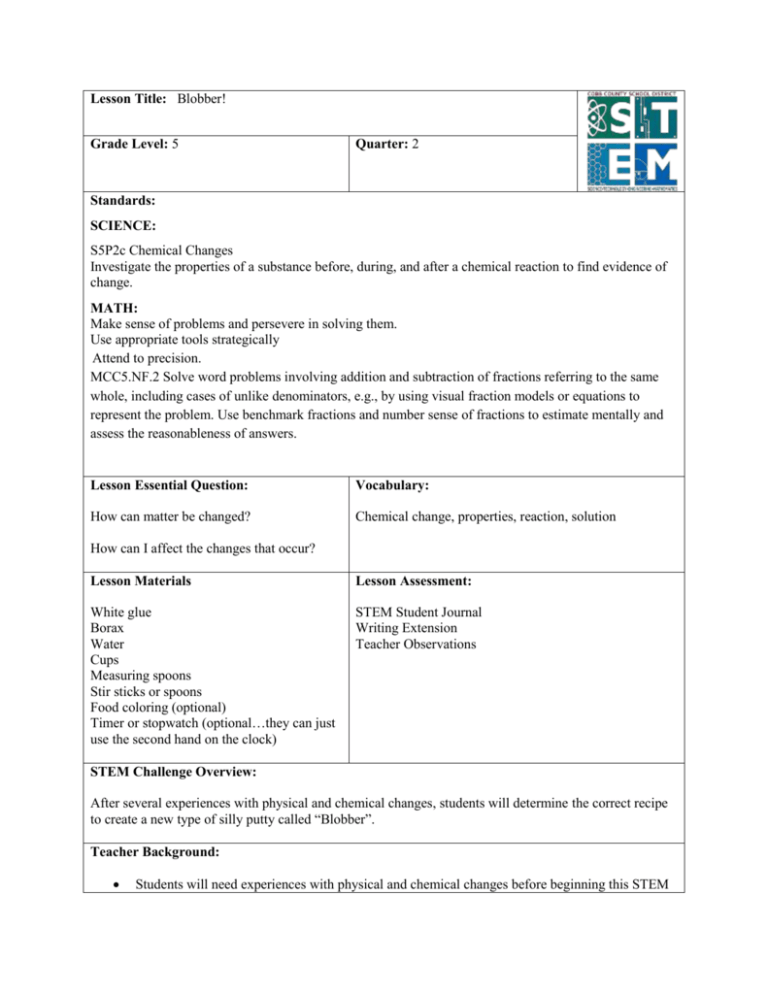
Lesson Title: Blobber! Grade Level: 5 Quarter: 2 Standards: SCIENCE: S5P2c Chemical Changes Investigate the properties of a substance before, during, and after a chemical reaction to find evidence of change. MATH: Make sense of problems and persevere in solving them. Use appropriate tools strategically Attend to precision. MCC5.NF.2 Solve word problems involving addition and subtraction of fractions referring to the same whole, including cases of unlike denominators, e.g., by using visual fraction models or equations to represent the problem. Use benchmark fractions and number sense of fractions to estimate mentally and assess the reasonableness of answers. Lesson Essential Question: Vocabulary: How can matter be changed? Chemical change, properties, reaction, solution How can I affect the changes that occur? Lesson Materials Lesson Assessment: White glue Borax Water Cups Measuring spoons Stir sticks or spoons Food coloring (optional) Timer or stopwatch (optional…they can just use the second hand on the clock) STEM Student Journal Writing Extension Teacher Observations STEM Challenge Overview: After several experiences with physical and chemical changes, students will determine the correct recipe to create a new type of silly putty called “Blobber”. Teacher Background: Students will need experiences with physical and chemical changes before beginning this STEM challenge. Students will need open table space to test their recipes. Make sure that the students always dissolve their borax in their water to make a solution before adding it to the glue. White glue is made up of millions of polymers. When polymers are dissolved like they are in glue they slide around each other letting the glue flow. However, they are so long, that when they flow they get in each other’s way making the glue more viscous. Viscous means that glue flows more slowly than water. When you add a borax solution to the glue the polymers change. The borax makes them cross link or connect to each other like a net. The more tangled the polymers get the more water they trap creating a jelly like feel. Tangled molecules change and are even more difficult to pour. This makes the solution even more viscous than glue. The change that takes place to the polymers by adding the borax solution is a chemical change. INSTRUCTION 1. Ask/Engage Read the book: Super Science Concoctions, by Jill Frankel Hauser; ISBN 1-885593-02-3 and / or share the video: http://www.youtube.com/watch?v=ndDJysfZaIU Both of these share information about the failed invention that later became known as “Silly Putty”. Super Science Concoctions, by Jill Frankel Hauser talks about a mistake that paid off, “Try as he might, the chemist James Wright was never able to create rubber in the laboratory. But one of the mistakes did become a very popular toy. When he added boric acid to silicone oil he created a bouncing solid that oozed like a liquid. You probably know it as Silly Putty!” (pg. 152). Ask students to think about why Silly Putty was originally considered a failure. Why has it since been considered an excellent toy? Introduce the challenge. Challenge: The Brumby Toy and Game Company wants to develop their own version of Silly Putty, called “Blobber”. Our investigators found out that it is made of white glue, borax, and water, but they were unable to get the actual recipe. We need you to test out some different combinations to help us discover the best recipe for “Blobber” Students will need: White glue Borax Water Food coloring (optional) Cups for mixing (at least 8 per group, as they will be mixing 6 combinations and need 1 for mixing borax solutions. They can rinse and reuse that one) Measuring spoons Stir sticks or spoons 2. Imagine/Brainstorm Criteria: You must be able to: 1. Accurately measure and record each ingredient used. 2. Develop a plan to keep your various concoctions organized, so you know which is which (this becomes important later). 3. Complete the “Blobber Test” with at least one of your concoctions. Take a few minutes to let the students investigate all available materials. How are they the same or different? Which ingredient will make it stretchy? Bouncy? Do you think adding the borax will change the way the glue behaves? What is the water for? NOTE: During your investigation, please remind students that Borax is a chemical called sodium borate that is common in household cleaners. It is also found in some hand soaps, tooth pastes, and tooth whitening creams. While it is relatively safe, take precautions to avoid getting any in your mouth or eyes. 3. Plan/Design Give each student or group a copy of the “How Do I Make Blobber?” worksheet. Explain that this is where they need to keep a record of the various combinations they test out. Each concoction should be mixed in its own cup and labelled with the ingredients in the cup. BEFORE the students begin testing recipes, they must determine all possible combinations (Given the measurement options on the worksheet, there will be 6 possibilities). That way, you can spot check to be sure nobody is inadvertently duplicating a recipe. 4. Create / Test Students can begin following their recipes to create “Blobber”. NOTE: They will NOT use all of their borax/water solution. See step 3. 1. Dissolve the borax in the water to make a solution. 2. Pour the white glue into another cup (optional: food coloring). 3. Add one tablespoon of the borax solution to the glue and stir with a stick or spoon 4. Take the mixture out of the cup and knead it with your hands for several minutes. Each recipe will give you a different consistency. Some will look good and some won’t. As a group, choose your 3 best recipes. Label them A, B, and C. Use them to run the “Blobber Tests” (see attached worksheet). 5. Evaluate/Improve – and repeat Steps 1-5 Students evaluate their “Blobber”. Did it meet the established criteria? Did it pass the “Blobber Test”? How would students improve the recipe to make it a better product? Allow students time to create and test one more recipe of their own invention to see if they can improve upon the “Blobber” they already made. How could you multiply your recipe to make enough to sell for a 5th grade Rock Eagle fundraiser? Ex: to make 4 “Blobbers”, we would need 4T of glue and 2 tsp of borax. How much would we need to make 100 “Blobbers”? If 4T equals ¼ c, how many cups of white glue would we need? Extensions: Develop a packaging concept and advertising campaign. How would you convince consumers to buy your putty instead of Silly Putty? Determine how much you would have to sell your 100 “Blobbers” for in order to earn a profit of $200? Remember to find out (research) the cost of your materials and subtract that from your earnings. NOTES *Working as individuals, pairs, or groups is entirely up to the classroom teacher. *While the goal is for the students to work independently, if you see a student struggling it is always a good idea to help guide their thinking. What’s going wrong? What are you trying to do? What might help fix this problem? Once they verbalize these things, you can offer a few suggestions for what might help. *The improvement step is very important to the STEM process. It is the step that teaches students to stick with it, “if at first you don’t succeed…” and all that. If their “Blobber” worked great the first time, this step pushes them into a higher level of thinking about their invention. If it failed the first time, this step teaches them to continue thinking, evaluate their own work, and possibly change strategies. This is what we are trying to get to transfer over to their academics. *Student journal pages are attached to this lesson. Feel free to alter them to suit your needs. Blobber Tests Collect and record your data from each recipe A B C Bounce Test Drop your Blobber from a height of 100cm. Use a meter stick the measure how high each bounces. Roll Blobber into a ball. How long does it stay in a ball? Roll Blobber into a ball again. This time, press a paper clip into it. How long does the imprint last? Which Blobber stretches the best? Measure it to the nearest quarter inch. Secret Message Test - Write a secret message with a pencil. Make sure the writing is dark. Press your blobber onto the message. What happens?_________________________________________________ _____________________________________________________________________________________ _____________________________________________________________________________________ Which recipe would you use for your final product and why?____________________________________ _____________________________________________________________________________________ _____________________________________________________________________________________ NOTE: You will NOT use all of their borax/water solution. See step 3. 1. Dissolve the borax in the water to make a solution. 2. Pour the white glue into another cup (optional: food coloring). 3. Add one tablespoon of the borax solution to the glue and stir with a stick or spoon 4. Take the mixture out of the cup and knead it with your hands for several minutes.
